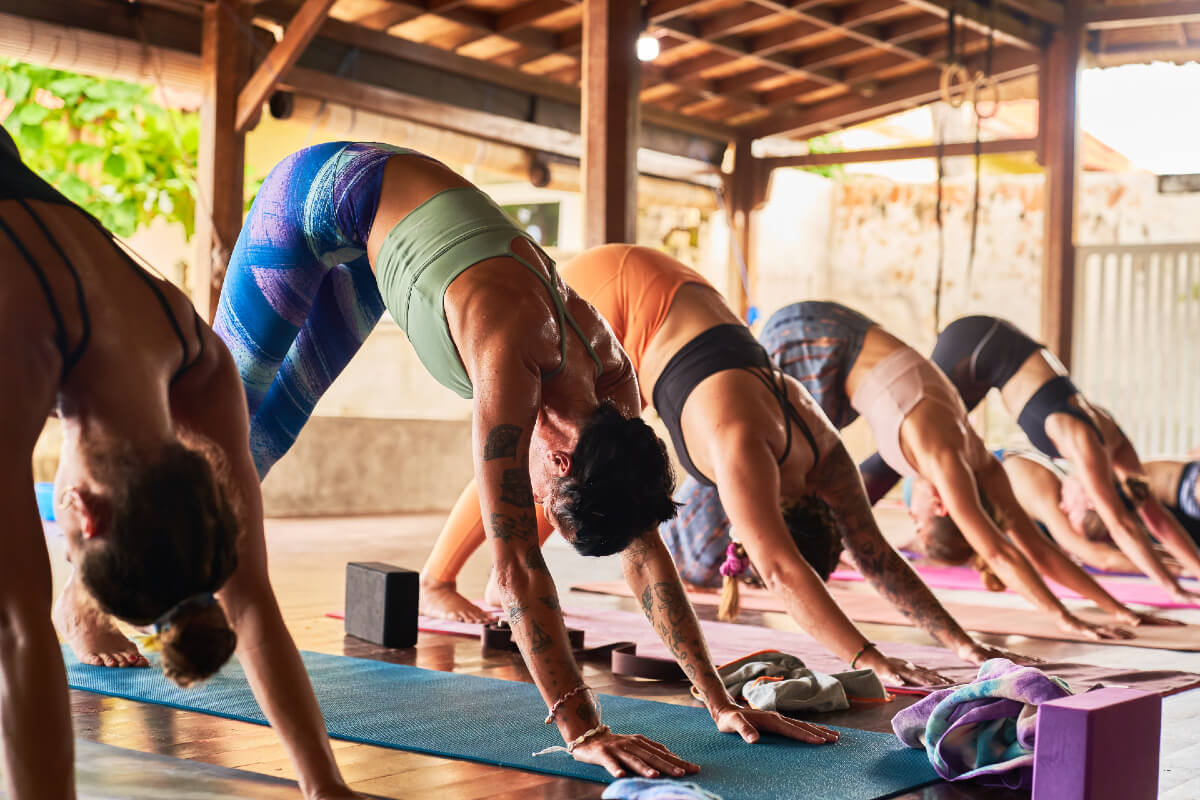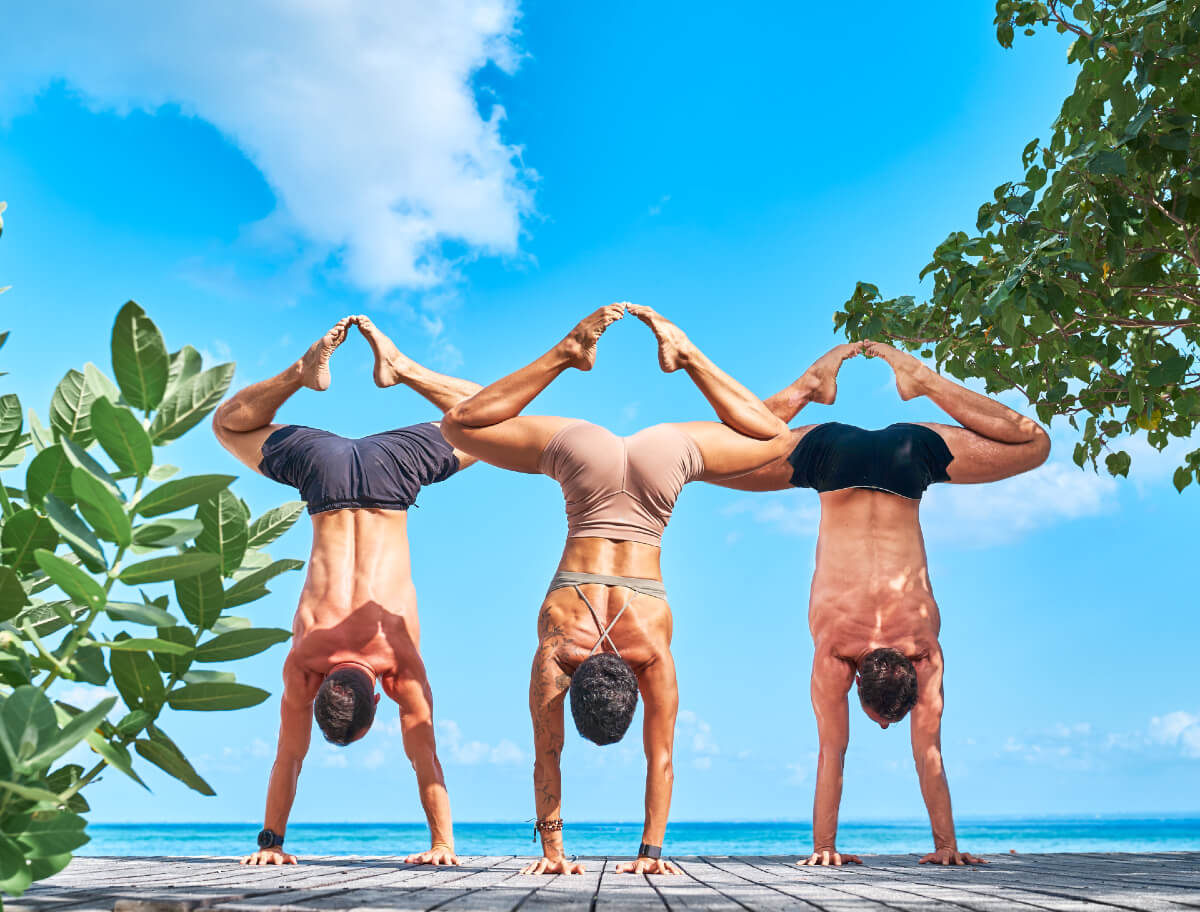Table of Contents
1. How to become a yoga instructor?
Step 1 – Practice Yoga Regularly:
Before you can teach yoga, you must first become a dedicated student. Yoga is a lifelong journey, and a solid foundation in your own practice is essential. Regular practice will not only deepen your understanding of yoga but also provide valuable personal insights that you can later share with your students.
Step 2 – Complete a 200-Hour Yoga Teacher Training (YTT):
To embark on the path of teaching yoga, enrolling in a reputable 200-hour Yoga Teacher Training (YTT) program is crucial. These programs are designed to provide you with a comprehensive understanding of yoga philosophy, anatomy, teaching methodology, and practice teaching. It’s advisable to choose a program registered with Yoga Alliance, as this ensures that it meets industry standards and guidelines.
Step 3 – Get Certified:
To earn your certification as a yoga instructor, you’ll typically need to pass a final examination at the end of your teacher training program. This examination may include written tests to assess your knowledge of yoga philosophy, anatomy, and teaching techniques, as well as practical assessments where you demonstrate your ability to guide yoga classes effectively.
Step 4 – Register with Yoga Alliance:
While not a legal requirement, registering with Yoga Alliance can significantly enhance your credibility as a yoga teacher. Many employers and yoga studios prefer to hire Registered Yoga Teachers (RYTs) with Yoga Alliance accreditation. It’s a way to signal to potential employers and students that you have met the highest standards in yoga education.
Step 5 – Find a Teaching Job or Start Your Own Class:
Once you’re certified, you can begin your teaching journey. Teaching opportunities can be found at yoga studios, fitness centers, community centers, and even online platforms. Consider your preferred teaching environment and the needs of your potential students when exploring job opportunities.
Step 6 – Consider Advanced Training:
As you gain experience and confidence as a yoga teacher, you may want to explore advanced training options, such as 300-hour or 500-hour certifications. These programs offer in-depth knowledge and advanced teaching techniques that can further enhance your skills as a yoga instructor. Remember that teaching yoga is an ongoing learning process, and the best teachers never stop expanding their knowledge.
2. How long should you practice before joining training?
It’s not about the duration, but the depth of your practice:
Contrary to the misconception that you must practice yoga for years before enrolling in a teacher training program, what truly matters is the depth of your practice. While some prospective yoga teachers come to training with several years of experience, others may have only practiced consistently for a few months. The key is to have a deep understanding of your practice, which includes yoga philosophy, history, and a good grasp of asanas (postures).
The importance of trying the style you plan to teach:
Before embarking on a teacher training program, it’s advisable to try the style of yoga you intend to teach. Whether it’s Ashtanga-Vinyasa, Hatha, or any other style, experiencing it firsthand will help you determine if it aligns with your teaching goals and resonates with your personal practice.
3. Is there an age limit?
Yoga is ageless:
There is no upper age limit when it comes to pursuing a yoga teacher training program. Yoga is a practice that can benefit individuals of all ages, and age should never be a deterrent. In fact, maturity can be a significant asset as a yoga teacher, as it often brings a deeper understanding of life and greater empathy.
The benefits of teaching at a mature age:
Teaching yoga at a more mature age can have its advantages, especially when instructing students who may relate better to a teacher with life experience. Your age can be a source of inspiration and wisdom for your students, and it can contribute to creating a nurturing and supportive learning environment.
4. Nervous about teaching?
Embrace the learning process:
It’s completely normal to feel nervous about teaching, especially if you’re new to it. Public speaking, after all, ranks among people’s greatest fears. However, keep in mind that teaching yoga is a skill that can be developed and refined with practice. The more you teach, the more confident and skilled you will become.
Practice is the key to confidence:
Like any other skill, teaching yoga improves with practice. Don’t let initial nervousness deter you from pursuing your passion. In your yoga teacher training program, you’ll have ample opportunities to practice teaching your fellow students in a supportive and encouraging environment. The sooner you start teaching, the quicker you’ll overcome your nerves and develop into a confident yoga instructor.
5. Worried you’re not good enough?
Yoga is not about perfection:
One common concern among aspiring yoga teachers is the fear of not being “good enough.” It’s crucial to dispel the misconception that yoga is solely about mastering advanced poses, extreme flexibility, or physical prowess. While physical aspects are a part of yoga, they are not the sole focus.
The depth of yoga goes beyond physicality:
Yoga is a profound and holistic practice that encompasses physical postures, breath control, meditation, philosophy, and self-awareness. Your ability to teach and inspire as a yoga instructor goes far beyond performing complex poses. Focus on sharing the essence of yoga, which is about self-discovery, mindfulness, and personal growth. Your uniqueness and genuine passion for yoga will make you more than “good enough” as a teacher.
6. Not planning to teach after training?
Yoga teacher training benefits beyond teaching:
Not everyone who undergoes a yoga teacher training program intends to become a registered yoga teacher. Some participants enroll for the sheer love of yoga and the desire to deepen their practice and knowledge. Rest assured, your training will be incredibly valuable, even if you don’t plan to teach right away.
Expanding your horizons:
Yoga teacher training programs delve into yoga philosophy, history, anatomy, and much more. This in-depth understanding of yoga will enrich your personal practice, enhance your self-awareness, and provide you with valuable tools for leading a balanced and mindful life. Additionally, should you ever decide to teach in the future, your training will serve as a solid foundation.
7. Can men join?
Yoga is for everyone:
Absolutely! Yoga is an inclusive practice for people of all genders and backgrounds. While it’s true that the majority of yoga practitioners in some regions may be women, this should not deter men from pursuing yoga teacher training. In fact, men can make valuable contributions to the yoga community.
Encouraging more men to practice:
Male yoga teachers can play a crucial role in encouraging more men to embrace yoga. Many men benefit greatly from yoga’s physical and mental benefits, and having male instructors can make the practice more relatable and accessible to other men. Yoga is truly for everyone, regardless of gender.
8. How long does it take to become a yoga teacher?
Variable timelines:
The duration of your journey to becoming a yoga teacher can vary significantly depending on various factors, including the type of training program you choose and your availability. The most common starting point is a 200-hour Yoga Teacher Training (YTT), which is the minimum requirement for certification.
Part-time vs. full-time:
If you opt for a part-time YTT program,
it may take three to five months to complete, as you’ll attend training sessions while managing other commitments. On the other hand, if you choose an intensive full-time program, you could complete the training in a month or even less.
The journey continues:
Once you’ve obtained your certification, remember that yoga is a journey, not a destination. Teaching is a continuous learning process, and ongoing practice and study are essential to becoming an accomplished yoga teacher. Your journey as a yoga teacher is just beginning.
9. What certification do you need?
Start with a 200-hour YTT:
If you’re considering teaching yoga, it’s advisable to begin with a 200-hour Yoga Teacher Training (YTT) program. These programs provide a solid foundation in yoga philosophy, poses, and teaching techniques. They are typically the entry-level requirement to become a certified yoga teacher.
Yoga Alliance accreditation:
To ensure that your training meets industry standards, look for programs that are certified by the Yoga Alliance. While not mandatory, this accreditation provides a level of assurance regarding the quality and comprehensiveness of the training.
Ongoing learning:
Keep in mind that the journey doesn’t end with certification. The best yoga teachers are committed to lifelong learning and continuous improvement. Consider pursuing higher-level certifications, such as 300-hour or 500-hour YTT programs, to deepen your knowledge and teaching skills.
10. Can you teach immediately after training?
Ready to teach after training:
Upon successfully completing a reputable yoga teacher training program, you are generally well-prepared to start teaching yoga immediately. The comprehensive training equips you with the necessary knowledge and skills to guide yoga classes effectively.
Additional certifications:
While you can start teaching right away, some employers or yoga studios may require additional certifications, such as becoming a Registered Yoga Teacher (RYT) with Yoga Alliance. This registration is not mandatory but can enhance your credibility in the industry.
The journey of learning:
Remember that becoming an exceptional yoga teacher is an ongoing journey. Teaching yoga is not just about the certification but also about continuously refining your teaching methods, deepening your understanding of yoga, and adapting to the evolving needs of your students.
11. What kind of yoga mat should you bring?
Choosing the right mat:
Selecting the appropriate yoga mat for your teacher training is essential. Keep in mind that you’ll be using it extensively, and it should cater to your specific needs. Here are some considerations:
Sweat resistance: Given the intensity of teacher training and the likelihood of sweating, opt for a mat designed for hot yoga or one that provides a non-slip surface. Yoga towels can also be helpful for absorbing sweat.
Portability: If you’re traveling for your training, consider the weight and size of your mat. Ensure it fits comfortably in your luggage.
Durability: Invest in a mat that can withstand daily use and won’t deteriorate quickly. A balance between quality and price is crucial.
Support: Choose a mat that provides adequate cushioning and support for your joints during asana practice. Your comfort is essential, especially during long training sessions.
Mat care:
Remember to care for your mat by cleaning it regularly and keeping it hygienic, as you’ll be sharing it with fellow trainees during practice sessions.
12. What does a typical day in training look like?
A structured day:
Yoga teacher training programs follow a structured daily schedule designed to provide a well-rounded education. While specific schedules may vary, here’s a general overview of what you can expect:
Morning study: Typically begins with meditation, pranayama (breath control), and asana practice to energize and prepare you for the day.
Brunch break: A mid-morning break for nourishment and relaxation.
Lecture: Informative sessions covering various aspects of yoga, including philosophy, anatomy, and group discussions to deepen your understanding.
Tea break: A short break for rejuvenation and a moment to connect with fellow trainees.
Asana clinic: Focused sessions on teaching techniques and elements of instruction, often involving group work.
Yoga practice: Led classes or self-practice sessions to reinforce your own practice and experience different teaching styles.
Adaptation:
While this schedule provides a general structure, it’s important to adapt to the specific program you choose, as each training may have its unique curriculum and daily rhythm.
13. Where in the world should you train?
A global choice:
Yoga teacher training programs are available worldwide, offering a rich diversity of locations and cultures. Your choice of location depends on your preferences and the experience you seek.
Research is key:
When selecting a training destination, research is essential. Ensure that the yoga school you choose is registered and reputable, with experienced instructors. Reading reviews and seeking recommendations can also help you make an informed decision.
Top destinations:
Some regions are particularly renowned for their yoga teacher training programs. Bali and Thailand, for instance, offer tropical climates and stunning surroundings for an unforgettable experience. These destinations provide unique charm and sceneries that can enhance your training journey.
14. When to go?
Consider the climate:
The timing of your yoga teacher training program can depend on the climate of the chosen location. It’s important to be aware of the weather patterns to ensure a comfortable and enjoyable training experience.
Ideal times:
For destinations like India and Thailand, the period from November to February is generally considered the best time, as it aligns with more favorable weather conditions. In Bali, the dry season from April to October offers the most enjoyable training environment.
Personal preferences:
Ultimately, the timing of your training should align with your personal preferences, availability, and the specific climate you enjoy. Planning in advance and considering seasonal factors can enhance your overall experience.
15. How much should you budget?
Beyond course fees:
When budgeting for your yoga teacher training program, it’s essential to consider expenses beyond the course fees. Here are some additional costs to keep in mind:
Food: Most training programs do not include full meals, so budget for daily breakfasts and dinners. Costs can vary depending on the location.
Visas: Check the visa requirements for your chosen training destination and factor in the cost and processing time.
Laundry: Frequent yoga practice means frequent laundry. Be prepared to pay for laundry services or self-service facilities.
Vaccines: Depending on your home country and the destination, you may require vaccines. Research and budget accordingly.
Onward travel: If you plan to stay on or travel after your training, allocate funds for additional accommodation, food, and travel expenses.
Plan wisely:
Budgeting wisely ensures that you can fully enjoy your training experience without financial stress. Be thorough in your financial planning to cover all aspects of your journey.
16. What style should you train in?
Hatha, Vinyasa, or Ashtanga-Vinyasa?
Yoga teacher training programs often offer different styles of yoga to choose from. Here’s a closer look at some common styles:
Hatha yoga: Often used to describe general ‘flow’ yoga, Hatha classes are typically slower-paced, with poses held for several breaths. It’s a good starting point for many.
Vinyasa yoga: Known for its flowing sequences, Vinyasa yoga combines breath and movement in a dynamic and meditative practice. It’s a popular choice in the West.
Ashtanga-Vinyasa yoga: This style follows
a specific sequence of asanas, with an emphasis on breath-movement coordination. It provides a strong foundation for teaching and self-practice.
Choose based on your goals:
Your choice of style should align with your teaching goals and personal preferences. Consider the style that resonates most with you and the type of classes you envision teaching in the future.
17. Pregnancy and yoga teacher training?
Not recommended during pregnancy:
If you are pregnant or planning to become pregnant in the near future, it’s generally not advisable to enroll in a rigorous yoga teacher training program. The intense physical and emotional demands of training may not be suitable during pregnancy, especially in the first trimester.
Opt for prenatal yoga:
Instead, consider participating in prenatal yoga classes, which are specifically designed to support pregnant individuals. After giving birth and resuming your regular yoga practice, you can then explore teacher training opportunities.
Remember that these considerations are vital to ensuring a positive and fulfilling yoga teacher training experience. Each aspect plays a significant role in your journey toward becoming a knowledgeable and confident yoga instructor. Ultimately, your commitment to learning and your passion for yoga will guide you on this transformative path.



